|
|
|
|
WORLD HERITAGE SITES IN PORTUGAL
OPORTO - PORTO
PORTO
Situated on the right bank of the River Douro, very close to its mouth, the city of Porto has a historical centre that still preserves a strong identity forged over many centuries and clearly visible in its remarkable buildings and unique urban fabric enlivened by the great vitality of the local inhabitants. Strategically close to the Atlantic coast, at a natural intersection of the routes travelled by people from both North and South, the city has always played an important role in international trade. Furthermore, not only did it escape the great waves of destruction that swept through so many other cities, but it is also fortunate enough to enjoy a geographical setting of exceptional beauty.
These were surely the reasons why UNESCO was to include Porto in its World Heritage list in 1996. This classification also extends to the left bank, taking in the Ponte de D. Luis, the city's emblematic iron bridge, built by a disciple of the famous Eiffel, the Mosteiro da Serra do Pilar and the wine lodges that line the river bank in Gaia, where that great ambassador of the city's name, Port Wine, is left to age before being sent to all corners of the world, bringing great pleasure to all those who drink it.
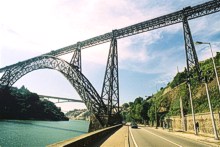
You should therefore begin your visit on this bank, for you will understand the city better once you have enjoyed this wonderful view of it climbing up the hills opposite. First of all, however, you should take the opportunity to sample the famous Port wine and listen to its story being told. It is also well worth your trouble to climb up to the Mosteiro da Serra do Pilar, from where you will gain an even more splendid view of the bend in the river, the bridge and the city. You should also visit the monastery, a Renaissance church that has the special peculiarity of a round cloister.Returning to the right bank, begin your tour at the cathedral, which was built in the twelfth century, in the time of D. Hugo, the city's first bishop, who also supervised the building of the first defensive walls. The great age of the cathedral can be seen in the bell towers, which give the building its appearance of a fortress church.
The powerful looking buttresses on the main facade stand either side of the original Romanesque rose window and the eighteenth century doorway. Also visible on the outside is a baroque loggia attributed to Nicolau Nasoni, which represents a later addition to the north face. Inside, the visitor's attention is drawn to the baroque chancel, with its magnificent altarpiece, and the altar of the Chapel of the Holy Sacrament, a most valuable work of' art from the seventeenth and eighteenth centuries, made by local silversmiths. At the south end of the cathedral is the elegant Gothic cloister, with its beautiful eighteenth century azulejos. This group of buildings includes the magnificent Episcopal Palace, also from the twelfth century, whose size reflects the early ecclesiastical dominance of the city that would later be curbed by the Crown's interests and the city's determination. The palace's present day external appearance is the result of its remodeling in eighteenth century, possibly under the supervision of Nicolau Nasoni. Slightly below the cathedral square is the church and convent of Grilos, built in the sixteenth century, with its impressive mannerist front.
In the area around the cathedral (crossing over Avenida de Vimara Peres) and close to the Igreja de Santa Clara are some stretches of the city's old Fernandine Wall. This was the second ring of defensive walls, with a perimeter of roughly 3,400 metres, completed in the reign of D. Fernando in the fourteenth century.
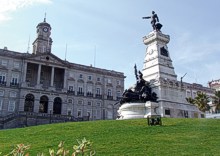
You should visit the church, which dates back to the fifteenth century, and admire its Renaissance doorway and remarkable interior, its walls lined with finely carved and gilded woodwork, one of the most typical features of Portuguese decorative art. Returning to Rua de D. Hugo, take some time to admire the attractive mansions emblazoned with their owners’ coats of arms, particularly the Casa-Museu Guerra Junqueiro, which houses the valuable collection of decorative art put together by this local poet and writer. Next to number 5 in this street, notice the only remaining visible section of the first medieval wall.At the end of the Middle Ages, Porto was a city with a thriving commercial activity, mostly carried out near the port and at the administrative facilities that can still be seen today on the quayside of Cais da Ribeira and in the customs house of the Casa do Infante. Other buildings and houses appeared as a result of this cosmopolitan activity, all of which were protected by the Fernandine wall. Between Rua da Fonte Taurina and Cais da Estiva, you can still see the opening in the wall made for the storage of coal, the only one that is now left.
In order to reach this area, you will have to walk down from the cathedral towards the river, passing through the popular Barredo quarter, down its steep, narrow streets and alleys. In the riverside area close to Cais da Ribeira, you will find a number of pavement cafes inviting you to pause for a while before continuing on to Largo do Terreiro and then into Rua da Alfandega. Here, on the right, is a typical sixteenth century house, which acted as the first royal customs house. Above the entrance, a stone inscribed with the date I894 testifies to the birth here of Prince Henry the Navigator five hundred years before.
Thereafter the building took the name of the Casa do Infante (the Prince's House), although it is most likely that the son of D. Joao I was born in the palace that his father had built in the area, and which has since been demolished. A little further up the hill is Rua do Infante Dom Henrique (formerly known as Rua dos Ingleses), where the impressive building known as the Feitoria Inglesa (the English Factory House) is to be found.
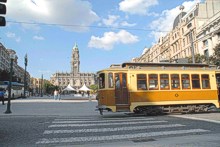
This same street leads into the square of the same name, which has a nineteenth century metal construction in the centre, Mercado Ferreira Borges, which used to be the city's main supply market, as well as a modest monument built as a memorial to Prince Henry. The neoclassical Palacio da Bolsa, commissioned in 1842 by the Porto traders to act as the city's stock exchange, is the dominant feature in this square.The great opulence of the different materials used to decorate the building's interior reveals an eclecticism that is unique in Portugal and reflects the important role played by commerce in the life of the city in the nineteenth century. Amongst its many interesting rooms, the most famous is undoubtedly the Arab Room, romantically inspired by the Alhambra palace in Granada. Side by side with the Palacio da Bolsa stands the lgreja de Sao Francisco. Although this was originally a Gothic church, it has become one of the city's most important baroque works. Above the main entrance on the west facade, attention is drawn to the various features added over different periods: its original beautiful rose window, symbolizing the wheel of fortune, is situated above the Renaissance doorway, itself flanked by baroque columns. Inside the church, the earlier Franciscan austerity has been completely superseded by the ostentatiousness of the 370 kg of gold that cover the baroque carved woodwork. Particularly impressive here is the altar with its famous ''Tree of Jesse''.
Turning now towards the mouth of the river, you can see the colourful and picturesque houses of Miragaia and, on the left, by the river bank, the imposing Customs House standing on an artificial platform, built on the site of a former beach and a remarkable example of nineteenth century engineering.
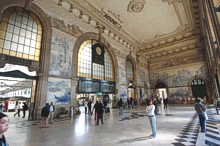
Returning once more to the lgreja de Sao Francisco, you should carry on to Largo de Sao Joao Novo, where the church with the same name is to be found, its severe but beautiful facade surmounted by two bell towers. From this square, you should set off down Rua de Belmonte (which previously marked the limits of the Jewish quarter), with its typical sixteenth and seventeenth century houses, whilst in the other direction is Rua das Taipas, whose most notable feature is a row of seven houses standing on carved granite consoles. In Rua das Virtudes, next to an old manor house is a terrace built on one of the towers of the old Fernandine wall.Returning once again to Rua das Taipas, your attention is drawn to the solid sturdy structure of' the Cadeia da Relacao, the former prison, which was rebuilt in the eighteenth century. Next to this is the lgreja de Sao Bento da Vitoria, built on the site of an old sixteenth century synagogue. Inside the church, the chancel provides another highly decorative example of baroque carved and gilded woodwork. Passing through the Jardim da Cordoaria, enlivened by a series of sculptures by Portuguese artists, you will emerge in of the baroque lgreja and Torre dos Clerigos, built by Nicolau Nasoni. The elegant tower is 75m high and has become the landmark of the city of Porto. In the street directly opposite he church, it is worth paying a visit to the Lello bookshop, whose inside is lined with some quiet remarkable carved woodwork.
Rua dos Clerigos leads to Praca da Liberdade, the city's main square in which there is a statue of D. Pedro IV on horseback, the liberal king who gave his heart to the city of Porto. The square extends into the Avenida dos Aliados, with the Town Hall at the top, giving the city a decidedly Nordic flavour. A little further below Praca da Liberdade is the Sao Bento railway station, which adds yet another contrast, this time one of French inspiration. The walls of the spacious entrance all are covered with decorative azulejos depicting important events in the history of Portugal, as well as scenes of everyday lift based on motifs drawn from agriculture, commerce and local customs.
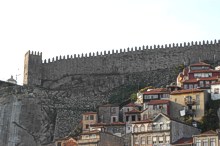
From here, you should make your way down Rua das Flores, which begins across the road from the station. It was built in 152I at the orders of the king D. Manuel I, the ground floor of the street being full of goldsmiths, jewelers and shopkeepers, who lived in the floors above their shops. It still preserves the delightful atmosphere of a bourgeois shopping area, reflected in the azulejos of the buildings, the beautiful designs the wrought iron balconies and the decorative ornaments framing the names of the shops. Squeezed into the middle of this bourgeois atmosphere is the baroque lgreja da Misericordia, with its imposing facade by Nicolau Nasoni.Returning to the Sao Bento railway station, walk up the hill to Praca da Batalha, where the most prominent buildings are the Sao Joao theatre and a manor house, which once housed the central post office. This marks the outer limit of the classified area.
The charms of this city are not limited to the area contained within its ancient walls. You must also make sure to enjoy a tram ride to the delightful Foz do Douro at the mouth of the river, as well as pay a visit to the Museum of Contemporary Art, set in the magnificent Serralves gardens and the Soares dos Reis Museum housed in the beautiful Palacio das Carrancas.
But do not think that this is all. As if it has been overcome by a certain timidity, Porto is reluctant to reveal itself completely at first sight. You have to train yourself to look for the details, the contrasts, the sudden unexpected balconies overlooking the River Douro, learning how to appreciate its discreet light. Make sure that you go inside the shops, cafes and cake shops, for it is here that the warmth and friendliness of the people will show you yet another feature of the city’s world heritage.
Text provided by the Portuguese Tourist Office